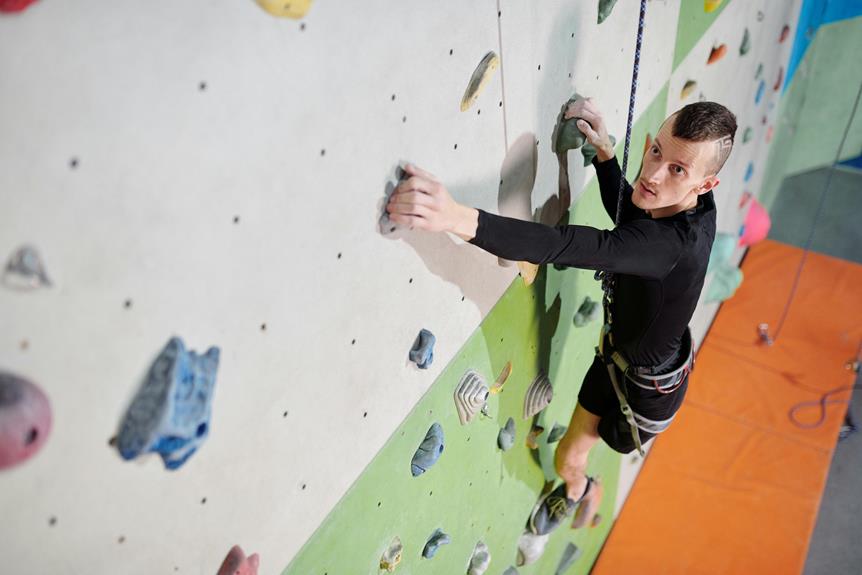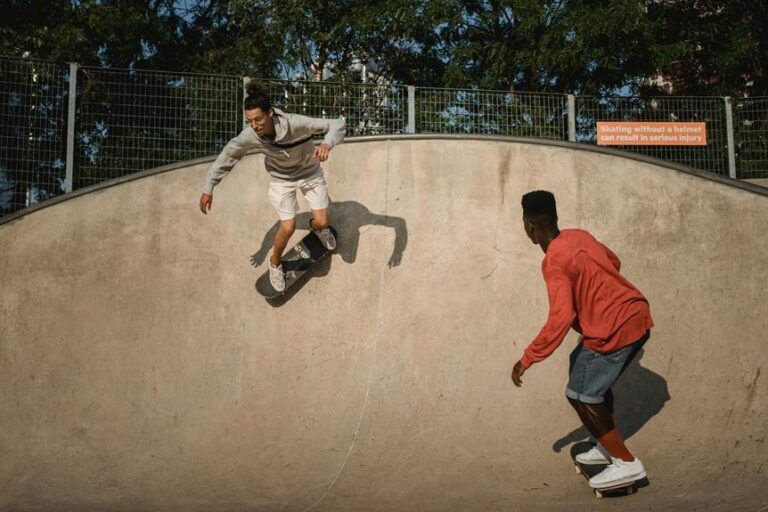Why Isnt My Dunking Height Improving?
If you’re struggling to improve your dunking height, it could be due to several factors. Common mistakes in your technique, such as not focusing on your vertical jump or lacking proper footwork and strength training, may be holding you back.
Pay attention to your jump mechanics, coordinate your arms with your movements, and guarantee you explode off the ground with power. Additionally, work on your foot positioning, strengthen your lower body through exercises like squats and lunges, and enhance your core stability with planks and leg raises.
Incorporating plyometric exercises can also target explosive power and improve your jumping ability. By addressing these areas, you can overcome hurdles in reaching higher dunking heights.
Key Takeaways
- Focus on improving vertical jump through specific training techniques.
- Ensure proper footwork for optimal force transfer and balance.
- Strengthen lower body muscles crucial for explosive jumps.
- Develop core stability to enhance power transfer and efficiency.
- Incorporate plyometric exercises to boost explosive power and jump height.
Common Mistakes in Dunking Technique
If you frequently find yourself wondering why your dunking height isn’t improving, it’s crucial to address common mistakes in dunking technique.
One key factor affecting your ability to soar high for a slam dunk is your vertical jump. To enhance this, incorporating strength training into your routine can make a significant difference. By strengthening your leg muscles, you’ll be better equipped to explode off the ground with power and reach greater heights.
Additionally, focusing on the mechanics of your jump, including the proper coordination of your arms and timing of your movements, can also help improve your vertical leap. By fine-tuning these aspects of your jump, you’ll be more able to dunk successfully and elevate your game to new heights.
Importance of Proper Footwork
Improving your dunking height greatly relies on mastering the importance of proper footwork in generating the power and momentum essential for an explosive jump. When focusing on footwork for dunking, consider the following:
- Correct foot positioning and alignment optimize force transfer from the ground, enhancing vertical height.
- Improving footwork efficiency minimizes energy loss, maximizing propulsion for successful dunks.
- Balance and stability during takeoff are influenced by precise footwork, aiding in achieving greater height and control.
- Focus on foot placement, push-off technique, and coordination to enhance the efficiency and effectiveness of your dunking jumps.
Mastering these aspects of footwork can have a significant impact on your vertical leap and dunking abilities.
Role of Lower Body Strength
Mastering proper footwork lays the foundation for enhancing your dunking height; however, the role of lower body strength is equally essential in achieving explosive vertical jumps and successful dunks.
Strengthening muscles like quadriceps, hamstrings, glutes, and calves through exercises such as squats, lunges, deadlifts, and calf raises directly impacts your dunking height.
Below is a table highlighting the importance of lower body strength training for improving your vertical leap:
| Benefit | Explanation |
|---|---|
| Increased Power | Strong lower body muscles generate the force needed for higher jumps. |
| Enhanced Stability | Improved strength leads to better balance and control during take-off. |
| Injury Prevention | Strengthening lowers the risk of injuries associated with high-impact activities. |
Focus on lower body strength training to boost your vertical leap and enhance your dunking performance.
The Impact of Core Stability
To maximize your dunking potential, developing strong core stability is essential for maintaining control and power during explosive movements.
Incorporating core-strengthening exercises like planks, Russian twists, and leg raises into your routine would enhance your core strength, leading to improved explosive power and the ability to jump higher.
A strong core helps transfer force efficiently from your lower body to your upper body, boosting overall power in jumping and dunking. Weak core muscles can result in energy leakage and reduced power output, limiting the height and explosiveness of your jumps.
Incorporating Plyometric Exercises
Enhance your dunking height by incorporating plyometric exercises into your training routine. Plyometric exercises target the stretch-shortening cycle vital for improving your vertical jump.
By including plyometrics, you can boost your explosive power and enhance your jumping ability, ultimately leading to an improvement in your dunking height.
Effective plyometric exercises for increasing dunking height include box jumps, depth jumps, and squat jumps. These drills specifically work on developing fast-twitch muscle fibers, which are essential for explosive movements like dunking.
Consistent practice of plyometric exercises is essential as it can result in significant gains in your vertical leap and overall dunking height.
Understanding Jump Mechanics
To understand how to enhance your dunking height further, it’s important to grasp the intricacies of jump mechanics, including the interplay of horizontal and vertical components. Here are some vital points to contemplate:
- Horizontal Speed: Utilize speed and momentum to boost your vertical jump for dunking.
- Principles from High Jump: Integrate leg stiffness, eccentric strength, and elasticity into your training program.
- Effective Transfer of Momentum: Learn from athletes like Stefan Holm to maximize your dunking height.
- Distinct Mechanics: Understand ground contact times and movement patterns to improve your dunking ability.
Overcoming Plateaus in Vertical Jump
If you’re struggling to break through plateaus in your vertical jump height, consider adjusting your training approach to target specific muscle weaknesses.
Plateaus can happen if you’re not allowing enough time for your muscles to recover between sessions.
Overtraining without adequate rest can hinder your progress in improving your vertical jump. To overcome these plateaus, focus on addressing weaknesses in key muscle groups.
Monitor and adjust your training program by varying intensity and volume to break through these barriers.
Incorporating challenging plyometric exercises can also help push past stagnation in your dunking height progress.
By targeting specific muscle groups, adjusting your training program, and incorporating plyometric exercises, you can overcome plateaus and continue to improve your vertical jump height.
Balancing Speed and Power
How can you effectively balance speed and power to optimize your dunking height? To enhance your dunking abilities, consider the following:
- Incorporate Speed Training: Focus on drills that improve your sprinting speed and agility, as speed plays a vital role in achieving greater vertical height during a dunk.
- Build Power Through Plyometrics: Engage in plyometric exercises like depth jumps and bounding to enhance your lower body explosiveness, translating into higher jumps for dunking.
- Utilize High Jump Techniques: Learn from high jump techniques to efficiently transfer momentum and energy, maximizing your dunking potential.
- Enhance Leg Strength and Elasticity: Work on developing leg stiffness, eccentric strength, and elasticity through targeted exercises to boost your speed and power output for higher jumps.
Addressing Mental Blocks in Dunking
Overcoming mental barriers is essential in elevating your dunking performance. Fear of injury or failure can create mental blocks that hinder your progress.
To combat these fears, try visualization techniques. Picture yourself successfully completing a dunk to build confidence and reduce anxiety. Additionally, engaging in positive self-talk and confidence-building exercises can help reshape your mindset for success on the court.
Consider seeking support from a sports psychologist or mental coach who specializes in overcoming athletic mental blocks. They can provide you with tailored strategies to address your specific fears and doubts.
Remember to set small, achievable goals to track your progress and celebrate your successes along the way.
| Techniques | Benefits |
|---|---|
| Visualization | Builds confidence |
| Positive self-talk | Improves mindset |
| Sports psychologist | Specialized support |
Frequently Asked Questions
How Can I Increase My Jump Height for Dunking?
To boost your dunking ability, focus on plyometric exercises like box jumps and depth jumps. Strengthen your lower body with squats and deadlifts. Combine speed drills with proper technique for best results. Keep pushing yourself to improve gradually.
Why My Vertical Jump Isn T Increasing?
Your vertical jump isn’t increasing due to lack of focus on specific plyometric exercises, inadequate rest periods, poor technique, prioritizing quantity over quality, and not tailoring your training to your individual needs. Time to tweak and soar!
What Height Is Too Short to Dunk?
If you’re wondering what height is too short to dunk, the reality is that dunking ability isn’t just about height. Focus on improving your vertical jump, strength, and technique to reach your dunking goals.
Why Can I Jump High but Can’t Dunk?
You’re flying high but missing the slam. Timing, coordination, and grip strength play key roles in successful dunks. Mastering the leap-to-dunk shift is crucial. It’s not just about height; it’s about finesse.
Conclusion
So, despite all your efforts to improve your dunking height, it seems like you’re still stuck in the air. Maybe gravity just really likes you and wants to keep you grounded.
Or maybe, just maybe, it’s time to reevaluate your training routine and focus on the fundamentals. Keep pushing yourself, stay consistent, and who knows, maybe one day you’ll finally soar like a basketball-playing bird.
Keep reaching for those hoops!









